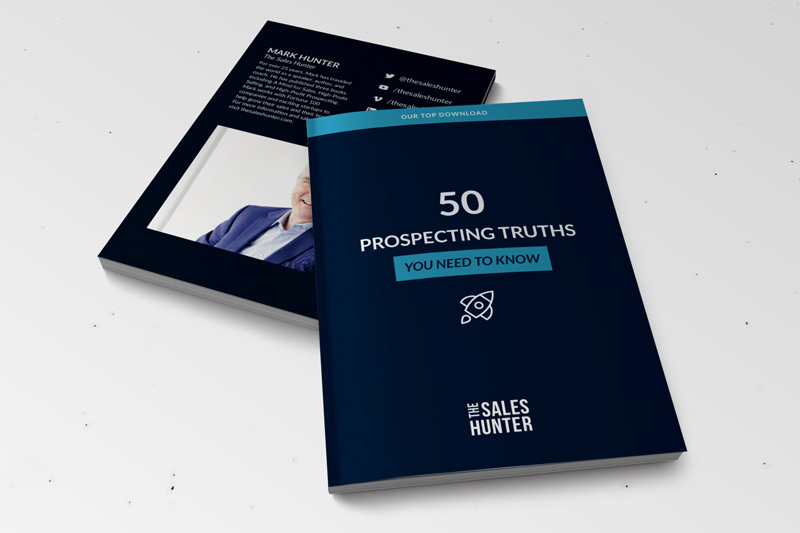Meridith: All right, Mark. So here we go. It is time for another great show and another great kickoff.
Welcome to Sales Logic. The show where we dive into the strategies, we discover the tactics, everything that you need to know to well sell logically. I’m Meredith Elliott Powell, and I’m here with my cohost,
Mark: Mark Hunter, the Sales Hunter. Great to see you today. Looking forward to a fantastic show. What’s on tap?
Meridith: Well, we are going to talk about prospecting. Today we’ve got some really good, topics to discover, but the way that the show works for many of you who are joining us again. In every single show, we do three things: number one, we cover a topic. Number two, we answer a listener question. That’s right. This show is really about you. So if you have
Mark: questions for the vanilla solution,
Meridith: it’s the solution to ensure sales reps make the, anything that go ahead.
Mark: No, I just going to say, we just want to get a little extra word in there from our sponsor, right? Because we do love Vanilla Soft.
Meridith: Yes, Vanilla Soft, our very great sponsor, has an unbelievable product, but I was talking about our question. And our question is, if you have a question, anything, that you need, go ahead and send us that question at our website saleslogicpodcast.com.
Again, saleslogicpodcast.com or just put it out there on social media and with #saleslogic. Make sure you stay till the end of this show, because we’re going to give you a lightning round. So with that, Mark, what do you say that we I’ll tell you what the question was?
Topic for the day is going to be about prospecting in the age of COVID. How important is prospecting and how has it changed? But before we dive into that, let’s kick off with our listener question and it is from listener Ned Coville. How do I build a strong follow-up list most specifically?
Where do I find the right people to prospect? Now, Mark, I want you to kick this off. Cause I ask this question a lot and he really put “right” in quotations, the right prospects.
Mark: Well, you start off by going to your existing customers. First of all, look at who they are, who are your existing customers? Why were you able to help them?
What did they, what did they achieve from buying from you? That’s the profile. You need to really create a prospecting persona, the persona of the person who you want to reach. That’s where you start. But here’s what I find. If you are creating value for your existing customers. Why don’t you go out and contact each of your existing customers and get a referral from them?
Well, guess what, that’s going to wind up giving you an additional pool of people that you can put in your prospecting list, but I don’t want to answer the whole, I know you got some ideas because you run down this path a lot. So jump in!
Meridith: Well, I’m going to dovetail a little bit with what you said, because I think the most important word in that question is right prospect and where I see people derail on prospecting is they’ve not thoroughly done a good job of understanding who’s right for them. And industry does not a prospect list to make a geographic region does not a prospect list make you need to understand your type. And so really, Mark, what you were talking about is taking those top 10 customers.
Top 10 customers are people that bring a smile to your face. If you thought that you were going to have to give them a call today, you’d be excited about it. They want to hear from you, they buy from you, they don’t quibble about price and they take your advice. Then really start to look at that list of 10 and you’ll start to see themes.
Certainly you’ll see the industry, the geographic location, but it will be more than that. You’ll see the type of person they are. Maybe they’re in an age strange. Maybe they’re family oriented. Maybe they’re the type of people that, you know, like sports or they’re more into the arts and the more you intimately understand them, you can start to mirror them. And when you mirror them, that’s going to land you in the right position. You don’t need a massive prospect list, but you need a right prospect list.
Mark: So key on that, because so many times what people do is they want to create as big of a prospecting list; therefore, they don’t want to define their perfect prospect. I say you get a better prospecting list by the tighter, the more qualifications you have for that prospect to be able to fit into your list. Because here’s what my goal is. I don’t want just a thousand prospects. I want 10 prospects that I can spend more time with.
The more time I spend with my prospects, my best prospects, the better the value I’ll create for them. The bigger, the solution I’ll be able to help them with and guess what? The better off they will be. And the better off I will be.
Meridith: Yeah, I call it, well, I call that niching to expand. And I think that, um, Amazon and Zappos really paved the way for us with this. You know, when Amazon first started out, I mean, it’s hard to imagine, but they were not targeting people like me and they understood that they were going after the person who thought that buying books online sounded like a good idea. That was not me. I, if you would have asked me 20 years ago, I would’ve told you we’d be buying books at our local bookstore forever, but they understood who their prospect was and content to sell to them. They convinced that prospect to buy from Amazon. Then that prospect sold the rest of us.
So the better that you understand that avatar, and don’t be afraid to focus small. I am going to add one controversial thing though. I get a lot of pushback from my clients on this. I think once you understand your perfect customer, you really need to think about your customer competitors.
And a lot of people say, well, I would never do that to my customers. Well, if your customers are not paying you for an exclusive. That you’re exclusively going to work for them, then I think you need to consider their competitors.
Mark: See, and I’m going to run with that for a second here, because I’m going to challenge this. I’m going to say that I don’t want to mirror my competitor. If my competitor’s going ying, I’m going yang. And when I go yang, that allows me to have a competitive difference versus my competitor. And when I get to that point, it’s amazing how much more successful I’ll be because now my customers see me in a different light.
Hey, with that though, we should probably jump over to the topic. The topic is prospecting in the age of COVID. How important is it to prospect and how has it changed? We were talking a little bit about this in the pre-show, but let’s really unpack this. We’re in the age of COVID it’s not going away tomorrow. I don’t know unless she knows something. I don’t know. So how important is it to prospect? How has it changed? Jump in.
Meridith: You know, it’s interesting. I was just listening to the news earlier this morning and they were talking about the fact that things are starting to go virtual into 2021 now. I definitely think this is with us for a while, but I think a lot has changed.
One of the very first things that changed is when I’m working with clients that I talk about is your prospects. Your first set of prospects in the age of COVID need to be your existing customers. And the reason is that number one, they need to hear from you. They need to know that you’re out there.
Number two is they’re prospects again, because their problems, their challenges and their issues have all changed since before COVID. You may think that these people have been your customers forever and you’ve taken great care with them. Maybe you have, but now all of a sudden, when the circumstances change, so do their challenges and opportunities and I call it securing your base. Before you move on to prospects back up, look at your existing customers and focus your time and attention there.
Mark: All add to that though. Don’t become so consumed with your existing customers that you don’t look past. You know, I talk about my book, A Mind For Sales, “CFT:” Customer Facing Time. How much time am I spending with my customers? And it can be easy, but then we become so fixated on our existing customers that we don’t look beyond. You gotta make sure that you’re also allocating time to go out and prospect new customers. In this age of COVID, you don’t know when some of your existing customers, maybe they’re all kind of in the same industry, could all of a sudden face difficult times. I have to make sure that I have a diversified customer base.
This brings up a very interesting piece that I challenge every salesperson right now, more than ever. You need to make sure that you have a diversified customer base. We get into trouble when we allow our business to be reliant upon only two or three or four customers. You always have to bring in new customers. And one of the ways that I suggest you do this is by picking up the telephone. It’s amazing how many people say how well the telephone’s working. Well, gee, you know what? It never went away, but people want to have a conversation more than ever right now. So those are just a couple of things that I see, but I know you see a lot of other things too. So, jump in.
Meridith: Well, I love this idea of diversifying your base. I mean, if you’re going to take anything from COVID and the uncertain marketplaces, that being diversified as always, you know, is always the safest bet.
The other way that it has changed is that, again, I really want to underline the fact that whatever techniques you were using to prospect engage prospects. Those techniques have changed because your prospect’s challenges, issues and opportunities have changed. So I think you have to be even more relevant in today’s marketplace.
I mean, one good thing that a good economy gets us is that we can skate a little, we can rest a little on our laurels, but in an uncertain marketplace and a challenging time, your prospects are looking for people that have the answers. You’ve got to focus time and energy on building your reputation in the marketplace.
Number one, do you understand the issues and challenges that your prospects are having? And then what are you doing to get the content out there that they see you as the expert, um, in that, you know, you it’s time to do, to be writing blogs, to be shooting videos, to be a guest star on a, um, on a podcast when you’re making those prospecting calls, you know, don’t make it down about you getting an appointment, make them about you adding value first.
Again, a technique that was always important. But it’s really, really, um, hypercritical in, uh, in the age of COVID. People are stressed. They have less time than they’ve had. So if they’re going to give you a time and I’ve always felt that a sales call is a gift, it’s a gift that a prospect gives to us and we should not waste their time. However, have to give them that gift before they ever grant you the opportunity of a sales call, and that comes in relevant information.
Mark: Your reputation really does arrive before you. And this is why I’m glad you brought that up in terms of what’s out there about you. What are you saying about you and what are others saying? Reputation rise for it. Here’s, here’s a couple of other things that I’ve seen- speed matters more than ever; speed sells. Now, what do we mean by speed sells? Speed of decisions. Because if we look over the last 120 days, we’ve seen so many economic variables go way up and come way down.
What does this mean? We’ve got to make it easy for our customers to buy from us by making it fast. One of the things that I tell salespeople is when you’re doing a prospecting call and you’re setting up that next week, don’t sit there and say, what’s your calendar look like for next week?
What’s your calendar look like this after, you know, get the meeting set up for this afternoon tomorrow, you have to make it expedient for a couple of reasons. Things change. There are so many variables that are changing in the marketplace that you can’t allow any moss to grow into your, and the other thing is make it simple for your customers.
We’re all seeing situation where when it’s a complex buy, when it’s a complex decision, lot of people get involved in this age of, of working from home and virtual decisions happened slowly. So you want to do is you want to make your sale as easy as possible for the person you’re speaking to, to make the decision, get in, become a vendor.
Oh, I hate using that term vendor, but get in with them. And then, so you’ve landed and then you can expand the age of selling in this world has changed because we are truly the solution provider, helping our customers see and achieve what they didn’t think was possible.
Meridith: Yeah, I would, I would agree with that.
I mean, the biggest challenges that people have right now is they need to be more efficient. They need to make sure that their business is going to be here. They need to do things that drive the bottom line. You need to be able to tie what your products and services are doing.
To be able to do that. You know, I think the moment that we entered it age, like COVID is this is really selling. I mean, a lot of times in a good economy it’s truly order-taking, but when it comes to prospecting, right. If you’re talking with a customer who clearly doesn’t want to buy your product or service. You know, it’s interesting, a friend of ours, Sam Richter, and I were talking with a person the other day, and we weren’t 10 minutes into the conversation where it was just clear the amount of excuses that the prospect was throwing, that this wasn’t a good avenue for us to go down. We just ended the call and moved on because the moment you say yes to one prospect, you’re saying no to 10 others. Recognize, you know, you definitely got to convince people understand the value that your brain to the table, but sometimes the prospect just isn’t there and the pie is really big. Sometimes you need to jusy move on, so sell from a place of power and prospect from a place of power, rather than a place of need.
Mark: When you say prospect from a position of power, that certainly is that’s also power, not to the point of arrogance, but power to the point that you can bring them. You can bring them information, because I really think you have to sell with integrity right now. If you cannot sell with integrity right now, you can’t be selling because of all the changes. That means you have to be willing to listen to the customer, like you’ve never listened before. Listening must be a true, active sport that unfortunately, back in the pre-COVID days, salespeople didn’t do; we just were too busy taking orders. Boy, we have to be listening.
Meridith: I just want to add on there, cause I think this is important. You not only need to listen, but then you need to use the language back that your prospect. The only way we know that we’ve been heard is when we hear what we just said. You have to use the same language back.
And I think you make such a great point that I don’t want to lose it is in times of crisis when people are hurting, they want to be heard more than anything. It’s one of the basic, most basic needs we have as human beings and as a sales professional. The prospect that is able to convey that they’ve heard is the one that’s going to make an emotional connection. You make that emotional connection, and you’re going to be in the driver’s seat.
Mark: And one way we hear is by playing back to them and asking them a question on what was shared with you. That’s how you make them really feel valuable. You and the customer will take you to the solution, but you have to ask the questions.
Whatever they share with you, just ask that question that just keeps building on it and building on it.
Hey, we should probably start kind of wrapping the shop, but we still got that lighting round that we got to do.
And of course, we want people to jump out to saleslogicpodcast.com. Leave the question because that’s what we always do. Or just post your question with #saleslogic on social media. We love hearing from our listeners. Let me tee up the lightning round and you take off and run with it. We’ll go back and forth several times.
What are your top prospecting tips? Go!
Meridith: Number one, get clear on your avatar. Know who your ideal prospect is.
Mark: To make sure you assign yourself prospecting time every day.
Meridith: Yeah. Number three is make a list and include no more than your top 20 prospects that you’re going to consistently work with. It is not going to be one touch and then close that deal. It’s going to be more than that.
Mark: Tip number four: don’t start what you can’t finish. Picking up on what you said. If you can’t build your way through 20 calls. Yes, that may be what it is using every medium possible don’t even start prospecting.
Meridith: No. I like to use a 70, 30 prospecting rule: 70% should be adding value. 30% should be asking for an appointment or getting business. Start to build that relationship and invest in them, before you ask them to invest in you.
Mark: Always stay focused on what outcomes you create. You have the outcomes from your best customers. That’s what you always want to be zeroing in on with every prospect you speak to.
Meridith: Clean it at least at least twice a year. Really go through the prospect list and ask yourself, is this still the best and highest use of my time?
Mark: And I’ll wrap it up by saying, if you can’t believe in how you can help people and the difference you can make. Then, you shouldn’t prospect or even be in sales.
With that, let’s wrap up the show by saying thank you to our listeners. If you like what you hear, subscribe, rate, and review the show on your favorite podcast app. If something we’ve said is earned you a single dollar, consider telling a friend about our show. It’s how we grow to help you grow. I’m Mark Hunter
Meridith: and I’m Meredith Elliot Powell.
Mark: Remember when you sell with confidence and integrity,
Meridith: uncertainty suddenly becomes your competitive advantage
Mark: and the sale becomes logical.
Meridith: Thanks, Mark. And we’ll see you all next week.
Copyright 2020, Mark Hunter “The Sales Hunter” Sales Motivation Blog. Mark Hunter is the author of A Mind for Sales and High-Profit Prospecting: Powerful Strategies to Find the Best Leads and Drive Breakthrough Sales Results.












